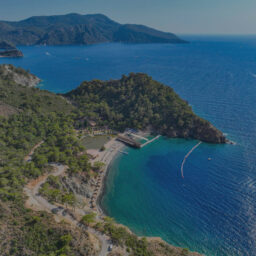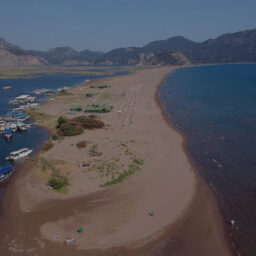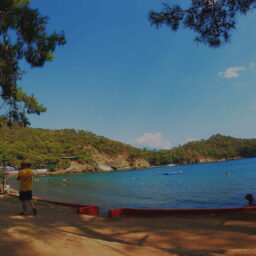Cubucak Forest Camp: Your Ultimate Destination for Outdoor Adventure
Cubucak Nature Park (Çubucak Tabiat Parkı) is a protected area in Turkey that covers approximately 6,900 hectares of land.
The park was established in 1998 and is managed by the Turkish Ministry of Environment and Urbanization.
The park is located near the city of Burdur, which is situated in the southwestern part of Turkey. The park is known for its unique ecosystem that comprises different plant and animal species.
It has become a popular destination for ecotourists who are interested in exploring nature and wildlife.
Cubucak Nature Park features hiking trails, picnic areas, and bird-watching opportunities, making it an ideal place for outdoor enthusiasts.
Location and size of the park
Cubucak Nature Park is located within the Taurus Mountains range on the eastern shores of Lake Burdur.
The park spans an area that covers about 6,900 hectares (16,000 acres) of land. It lies at an altitude ranging from 1,100 to 2,000 meters above sea level.
The park’s location provides a unique setting for biodiversity conservation within Turkey’s Mediterranean region.
The highlands surrounding Lake Burdur offer a habitat for various endemic plants and animals found nowhere else in the world.
Importance of the park for biodiversity conservation
Cubucak Nature Park plays an essential role in protecting Turkey’s rich biodiversity by providing a sanctuary for various plant and animal species found within its boundaries.
The park’s rich ecosystem supports several wildlife species such as wild boars, roe deer, wolves as well as many bird species including eagles, vultures and owls.
The vegetation cover includes juniper forests mixed with Mediterranean scrubland containing olive trees amongst other species endemic to this region such as Carob Trees or St.Johns Wort plants, many of which have medicinal properties.
Overall, the preservation of Cubucak Nature Park’s biodiversity is crucial to maintain the ecosystem services provided by the park.
These services include soil stabilization, water regulation and purification, carbon sequestration and climate regulation.
History of Cubucak Nature Park
Cubucak Nature Park was established in 2004 with the aim of protecting and conserving the unique biodiversity of the region.
The park is located in the province of Antalya, Turkey, covering an area of approximately 238 hectares.
Due to its rich flora and fauna, including several endemic and rare species, Cubucak Nature Park is considered one of the most important conservation areas in Turkey.
How the park was established
The establishment of Cubucak Nature Park was a collaborative effort between various stakeholders including local communities, NGOs, and governmental organizations.
The process started with a feasibility study that assessed the ecological value and potential threats to the area.
Following this assessment, a management plan was developed to guide the conservation efforts within the park.
In addition to its conservation goals, Cubucak Nature Park also serves as a research center for scientists studying biodiversity in Turkey.
Collaborative research projects have been undertaken by universities working with local communities to understand better how natural resources can be managed sustainably while still benefiting people’s lives.
Early management practices and challenges faced by park management team
Despite initial enthusiasm for its establishment after years of neglect, early management practices at Cubucak Nature Park were challenging due to lack of adequate resources such as personnel training or equipment for monitoring activities like illegal hunting or logging within or around its perimeters.
Lack of coordination among stakeholders also led to conflicts among them over different priorities that needed to be addressed before any significant progress could be made towards achieving ecological goals.
The challenges faced during these early days included difficulties in enforcing rules around illegal hunting practices within or around park boundaries which frequently occurred due largely because wardens patrolling around it could not do so efficiently due their lack of knowledge on how best deal these issues especially when dealing with more sophisticated methods employed by hunters utilizing technology like GPS trackers or drones.
Success stories and achievements over the years
Despite the initial challenges, Cubucak Nature Park has made remarkable progress over the years, with several success stories to its name.
The park has won several prestigious awards for its conservation efforts, including the European Commission’s Natura 2000 award for best conservation practices in 2012.
The park’s management team has also established partnerships with local communities to promote sustainable livelihoods while still conserving natural resources.
A particular success story within the park is the reintroduction of several rare and endangered species such as Anatolian leopards and griffon vultures back into their natural habitat.
These efforts have been undertaken through collaborations with various partners including universities, NGOs and government agencies working together towards achieving mutual objectives which benefit all parties involved.
Other achievements include increased public awareness about conservation issues through educational programs like nature walks and bird watching tours offered within or around park boundaries helping raise awareness about how best enjoy wildlife while still respecting it enough to ensure it can thrive sustainably for future generations.
Flora and Fauna in Cubucak Nature Park
Overview of Plant Species Found in the Park
Cubucak Nature Park boasts an impressive array of plant species, many of which are endemic to the region.
These endemic species are plants that are found nowhere else on Earth. The park is home to over 1,000 plant species, with more than 150 of them being endemic.
These include the beautiful Turkish cyclamen (Cyclamen turcicum), which can only be found in a few locations around Turkey.
In addition to these unique species, the park is also home to rare and endangered plants that have been identified as critically important for conservation efforts.
These include the Gundelia tournefortii, also known as “Turkish Delight,” which is a medicinal thistle plant used for traditional remedies against diabetes and high cholesterol.
Another important group of plants found in Cubucak Nature Park are medicinal plants.
The park has many different types of medicinal herbs that have been used for centuries by local people to treat various ailments such as colds, flu, and stomach disorders.
Some examples include Sage (Salvia officinalis), Thyme (Thymus vulgaris), and St John’s Wort (Hypericum perforatum).
Overview of Animal Species Found in the Park
The diverse habitats within Cubucak Nature Park provide homes for a wide variety of animal species including mammals, birds, reptiles and fish.
The park’s mammal population includes many different types such as squirrels, rabbits, foxes and badgers.
Larger mammals like Wild Boars (Sus scrofa) can be spotted exploring through forests while Suleiman’s Nine-banded Armadillo (Dasypus sabanicola) roam along riverbanks. Birdwatchers will be delighted at the range of feathered friends they can spot in the park.
Over 200 bird species have been recorded in the area, with many rare and endangered species like Eastern Imperial Eagle (Aquila heliaca) and Bonelli’s Eagle (Aquila fasciata). Other notable bird species include White-throated Robin (Irania gutturalis) and Olive-tree Warbler (Hippolais olivetorum).
The reptile population is also diverse, with snakes such as the Montpellier snake (Malpolon monspessulanus) and Blunt-nosed viper (Macrovipera lebetina), tortoises such as Tortoise Hermann’s (Testudo hermanni) and lizards like Agama stellio stellio.
In addition to these reptiles, the park is also home to several fish species found in its rivers and streams.
Activities to do in Cubucak Nature Park
Cubucak Nature Park offers visitors a range of activities, from hiking and bird watching to camping and picnicking.
With its diverse flora and fauna, visitors can enjoy the park’s natural beauty while participating in various recreational activities.
Hiking Trails and Nature Walks
The park boasts several hiking trails that vary in length and difficulty, making them suitable for both beginners and experienced hikers.
The most popular trail is the 5km long “Lakeside Trail”, which winds along the scenic lake shore and through wooded areas.
Along the way, hikers can observe various flora such as wildflowers, orchids, ferns, pines, oaks among others; as well as fauna such as tortoises, rabbits among other small mammals.
Nature walks are also available for visitors who prefer a slower pace. These guided walks allow visitors to learn about the park’s ecosystem while enjoying its natural beauty.
An expert guide will take you on a leisurely stroll around different parts of the park while explaining different features of interest.
Bird Watching Tours
Cubucak Nature Park is home to over 100 species of birds throughout the year making it an ideal destination for bird watchers during all seasons.
Bird-watching tours are available with experienced guides who will help you spot different species such as eagles, vultures, owls or warblers depending on season.
Visitors can also participate in bird-ringing programs where they get hands-on experience handling birds under supervision learning more about them including their anatomy,migration patterns,stress levels etc.
Camping,Picnicking,and Other Recreational Activities
For those who want to spend more time in nature than just a day visit,Cubucak nature park provides camping facilities within designated areas equipped with toilets,fire pits and running water.
Picnicking is also popular in the park with designated picnic areas for day visits and picnickers bring their own food,cutlery,chairs etc. to enjoy a peaceful day out.
Fishing is also allowed within the park, but visitors must have a valid fishing license as per regulations and should not harm or disturb aquatic animals.
Overall, Cubucak Nature Park provides an array of activities for visitors of all ages to enjoy while taking in the natural beauty of the park.
Challenges Facing Cubucak Nature Park Conservation Efforts
Illegal Hunting, Logging, Grazing, and Farming Activities Within or Around the Park
Despite the efforts of the park management team, Cubucak Nature Park faces numerous threats from human activities in and around its borders.
Illegal hunting is a significant concern as it affects both animal populations and the ecosystem.
Poaching for meat or sport threatens endangered species such as wild boars, roe deer, red deer, and brown bears.
Additionally, illegal logging activities pose a severe threat to the park’s ecosystems by disrupting soil formation processes and reducing forest cover.
Grazing and farming activities within or around the park also pose a threat to Cubucak’s conservation efforts.
Overgrazing can cause soil erosion, which may lead to landslides that destroy vegetation in the area.
Moreover, overuse of herbicides can affect water quality by introducing harmful chemicals into rivers and streams that run through the park.
Invasive Alien Plant Species that Threaten
Invasive plant species are another significant challenge faced by Cubucak Nature Park’s conservation efforts.
These plants compete with native plant species for limited resources such as water and sunlight.
They also have a negative impact on biological diversity by displacing native plant species that provide food and shelter for local wildlife.
Narrow-leafed ragwort (Senecio inaequidens), Coarse-leaved dogwood (Cornus macrophylla), Giant hogweed (Heracleum mantegazzianum) are some invasive alien plant species that threaten Cubucak’s biodiversity.
The management team has been working tirelessly to identify these invasive plants’ growth patterns so they can be adequately removed before they take over.
Conclusion
Cubucak Nature Park is an essential area for biodiversity conservation in Turkey; however, it is not immune to threats from human activities and invasive plant species.
Despite these challenges, the park management team remains dedicated to maintaining a healthy ecosystem.
With the help of local communities, tourists, and conservation organizations, Cubucak’s conservation efforts are promising.
Visitors can also play a vital role in supporting the park’s conservation by reporting any illegal activities and adhering to park rules during their visit.
Together we can ensure that Cubucak Nature Park remains a sanctuary for people and wildlife alike for generations to come.
Where is Cubucak Nature Park located and how big is it?
Cubucak Nature Park is located near the city of Burdur, in the southwestern part of Turkey, within the Taurus Mountains range on the eastern shores of Lake Burdur. The park spans approximately 6,900 hectares.
Why is Cubucak Nature Park important for biodiversity conservation?
The park provides a unique ecosystem and a sanctuary for various plant and animal species, including many that are endemic to this region. It plays a vital role in maintaining ecosystem services such as soil stabilization, water regulation, and carbon sequestration.
What are the primary activities available in Cubucak Nature Park?
The park offers a range of activities such as hiking, bird-watching, camping, and picnicking. There are nature walks, bird-ringing programs, and educational programs for visitors to enjoy while learning about conservation issues.
What challenges does Cubucak Nature Park face in its conservation efforts?
The park faces threats from human activities like illegal hunting, logging, grazing, and farming activities. Invasive alien plant species that compete with native plant species for resources also pose a significant challenge.
How can visitors help in the park's conservation efforts?
Visitors can play a vital role by reporting any illegal activities they observe and strictly adhering to the park's rules during their visit. This ensures the park remains a sanctuary for people and wildlife for future generations.

























